Question 1:
A dental firm is redesigning the network that connects its three locations. The administrator gave the networking team 192.168.164.0 to use for addressing the entire netwok. After subnetting the address, the team is ready to assign the addresses. The administrator plans to configure ip subnet-zero and use RIP v2 as the routing protocol. As a member of the networking team, you must address the network and at the same time conserver unused addresses for future growth. With those goals in mind, drag the host addresses on the left to the correct router interface. Once of the routers is partially configured. Move your mouse over a router to view its configuration. Not all of the host addresses on the left are necessary.

Answer:
 Explanation:
Explanation:
In short, we should start calculating from the biggest network (with 16 hosts) to the smallest one using the formula 2n – 2 (n is the number of bits we need to borrow).Therefore:
16 hosts < 25 – 2 (we need to borrow 5 bits -> /27)
11 hosts < 24 – 2 (borrow 4 bits -> /28)
5 hosts < 23 – 2 (borrow 3 bits -> /29)
From the available ip addresses, we see that each of them has only one suitable solution (they are 192.168.164.149/27,192.168.164.166/28 and 192.168.164.178/29)
The smallest network is the Floss S0/0 which only requires 2 hosts = 22 – 2 (need to borrow 2 bits ->/30). There are 2 suitable answers: 192.168.164.189/30 and 192.168.164.188/30 but notice that 192.168.164.188/30 is the network address so we can not use it (because 188 = 4 * 47) -> we have to choose 192.168.164.189 as the correct solution.
In fact, it is not the formal way to solve a VLSM question so I recommend you to review your CCNA book if you haven’t grasped it well yet.
Question 2:
In order to complete a basic switch configuration, drag each switch IOS command on the left to its purpose on the right
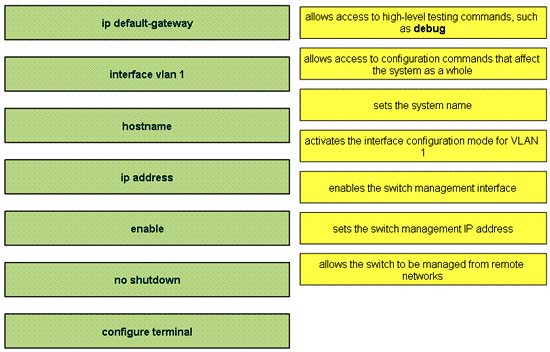
Answer:
1) enable
2) configure terminal
3) hostname
4) Interface vlan 1
5) no shutdown
6) ip address
7) ip default-gateway
Question 3:
The Missouri branch office router is connected through its s0 interface to the Alabama Headquarters router s1 interface. The Alabama router has two LANs. Missouri users obtain Internet access through the Headquarters router. The network interfaces in the topology are addressed as follows: Missouri: e0 – 192.168.35.17/28; s0 – 192.168.35.33/28; Alabama: e0 – 192.168.35.49/28; e1 – 192.168.35.65/28; s1 – 192.168.35.34/28. The accounting server has the address of 192.168.35.66/28. Match the access list conditions on the left with the goals on the right. (Not all options on the left are used.)
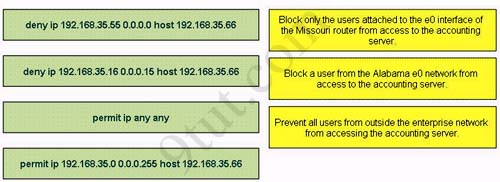 Answer:
Answer:
1) deny ip 192.168.35.16 0.0.0.15 host 192.168.35.66
2) deny ip 192.168.35.55 0.0.0.0 host 192.168.35.66
3) permit ip 192.168.35.0 0.0.0.255 host 192.168.35.66
Explanation:
1) The wildcard mask of the command “deny ip 192.168.35.16 0.0.0.15 host 192.16.35.66″ is 0.0.0.15, which is equal to network mask of 255.255.255.240 = /28. So the access list will deny all traffic from network 192.168.35.16/28 from accessing host 192.16.35.66, which is the IP address of accounting server.
2) The command “deny ip 192.168.35.55 0.0.0.0 host 192.168.35.66″ will deny host 192.168.35.55, which is a user and belongs to interface e0 of Alabama router (192.168.35.49/28) from accessing accounting server.
3) Because there is an implicit “deny all” command at the end of each access list so the command “permit ip 192.168.35.0 0.0.0.255 host 192.168.35.66″ will only let network 192.168.35.0/24 access accounting server whilst prevent traffic from other networks.
Question 4:
A host with the address of 192.168.125.34/27 needs to be denied access to all hosts outside its own subnet. To accomplish this, complete the command in brackets, [access-list 100 deny protocol address mask any], by dragging the appropriate options on the left to their correct placeholders on the right.
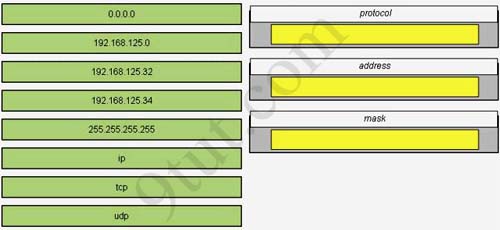
Answer:
1) ip
2) 192.168.125.34
3) 0.0.0.0
Full command: access-list 100 deny ip 192.168.125.34 0.0.0.0
Question 5:
Drag and drop the network user application to the appropriate description of its primary use (not all options are used)
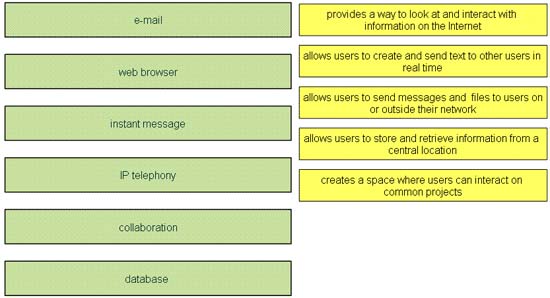
Answer:
1) web browser
2) instant message
3) e-mail
4) database
5) collaboration
Question 6:
This topology contains 3 routers and 1 switch. Complete the topology.
(Hint: use the given host addresses and Main router information)
To remove a device or connection, drag it away from the topology.
Use information gathered from the Main router to complete the configuration of any additional routers. No passwords are required to access the Main router . The config terminal command has been disabled for the HQ router. The router does not require any configuration.
Configure each additional router with the following
Note: Because routes are not being added to the configurations, you will not be able to ping through the internetwork.
All devices have cable autosensing capabilities disabled.
All hosts are PC’s
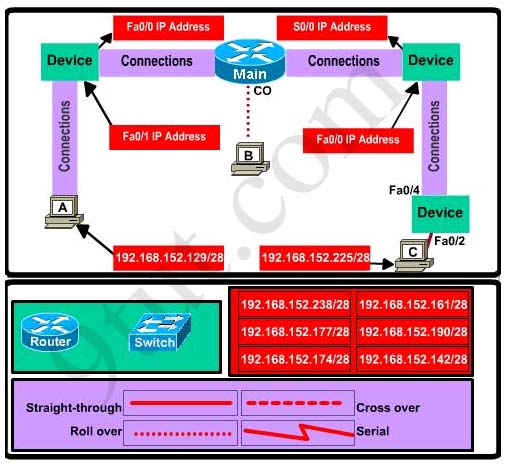 Answer:
Answer:
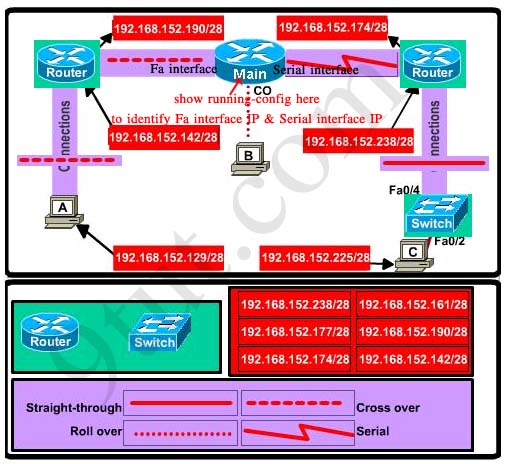
Question 7
The left describes OSI layers, while the right provides some terms. Drag the items on the right to the proper locations.
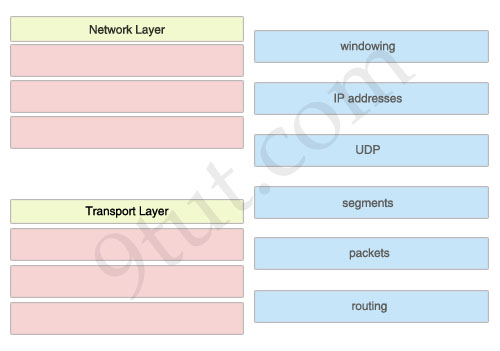
Answer:
Network Layer:
1) IP addresses
2) packets
3) routing
Transport Layer:
1) windowing
2) UDP
3) segments
Question 8
The above describes some categories, while the below provides their corresponding router output lines. Drag the above items to the proper locations.
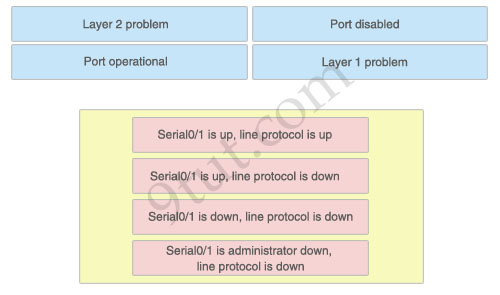 Answer:
Answer:
1) Port operational: Serial0/1 is up, line protocol is up
2) Layer 2 problem: Serial0/1 is up, line protocol is down
3) Layer 1 problem: Serial0/1 is down, line protocol is down
4) Port disabled: Serial0/1 is administrator down, line protocol is down
Explanation:
A simple way to find out which layer is having problem is to remember this rule: “the first statement is for Layer 1, the last statement is for Layer 2 and if Layer 1 is down then surely Layer 2 will be down too”, so you have to check Layer 1 before checking Layer 2. For example, from the output “Serial0/1 is up, line protocol is down” we know that it is a layer 2 problem because the first statement (Serial0/1 is up) is good while the last statement (line protocol is down) is bad. For the statement “Serial0/1 is down, line protocol is down”, both layers are down so the problem belongs to Layer 1.
There is only one special case with the statement “…. is administrator down, line protocol is down”. In this case, we know that the port is currently disabled and shut down by the administrators.
Question 9
A user is unable to connect to the Internet. Based on the layered approach to troubleshooting and beginning with the lowest layer. Follow the guide and drag the contents to relevant modules.
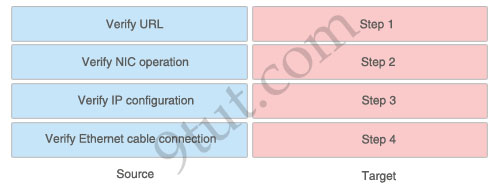
Answer:
1) Verify Ethernet cable connection: Step 1
2) Verify NIC operation: Step 2
3) Verify IP configuration: Step 3
4) Verify URL: Step 4
Explanation:
The question asks us to “begin with the lowest layer” so we have to begin with Layer 1: verify physical connection; in this case an Ethernet cable connection. For your information, “verify Ethernet cable connection” means that we check if the type of connection (crossover, straight-through, rollover…) is correct, the RJ45 headers are plugged in, the signal on the cable is acceptable…
Next we “verify NIC operation”. We do this by simply making a ping to the loopback interface 127.0.0.1. If it works then the NIC card (layer 1,2) and TCP/IP stack (layer 3) are working properly.
Verify IP configuration belongs to layer 3. For example, checking if the IP can be assignable for host, the PC’s IP is in the same network with the gateway…
Verifying the URL by typing in your browser some popular websites like google.com, microsoft.com to assure that the far end server is not down (it sometimes make we think we can’t access to the Internet). We are using a URL so this step belongs to layer 7 of the OSI model.
Question 10
The left describes the types of cables, while the right describes the purposes of the cables. Drag the items on the left to the proper locations. (Not all items can be used).

Answer:
1) straight-through: switch access port to router
2) crossover: switch to switch
3) rollover: PC COM port to switch
Explanation:
To remember which type of cable you should use, follow these tips:
- To connect two serial interfaces of 2 routers we use serial cable
– To specify when we use crossover cable or straight-through cable, we should remember:
Group 1: Router, Host, Server
Group 2: Hub, Switch
One device in group 1 + One device in group 2: use straight-through cable
Two devices in the same group: use crossover cable
For example: we use straight-through cable to connect switch to router, switch to host, hub to host, hub to server… and we use crossover cable to connect switch to switch, switch to hub, router to router, host to host… )
Question 11
The left describes the types of switch ports, while the right describes the features. Drag the options on the right to the proper locations.
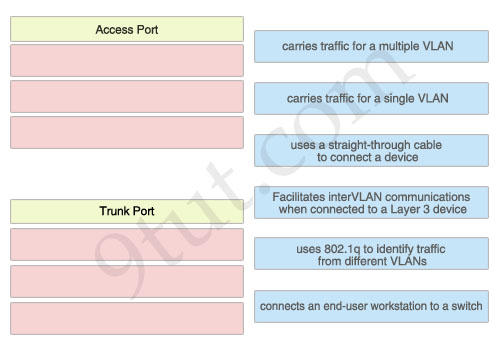
Answer:
Access Port:
- Carries traffic for a single VLAN
– Uses a straight-through cable to connect a device
– Connects an end-user workstation to a switch
Trunk Port:
- Carries traffic for a multiple VLAN
– Uses 802.1q to identify traffic from different VLANs
– Facilitates interVLAN communications when connected to a Layer 3 device
Question 12
The above describes the Spanning-Tree Protocol port states, while the below describes their functions. Drag the above items to the proper locations.
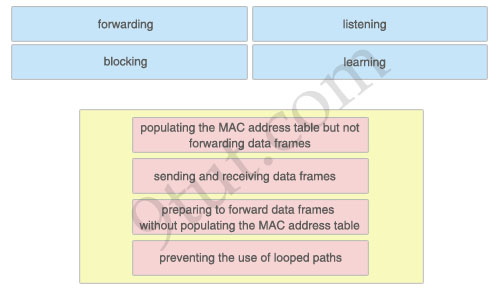 Answer:
Answer:
- Learning: populating the MAC address table but not forwarding data frames
– Forwarding: sending and receiving data frames
– Listening: preparing to forward data frames without populating the MAC address table
– Blocking: preventing the use of looped paths
Question 13
Drag the security features on the left to the specific security risks they help protect against on the right. (Not all options are used)
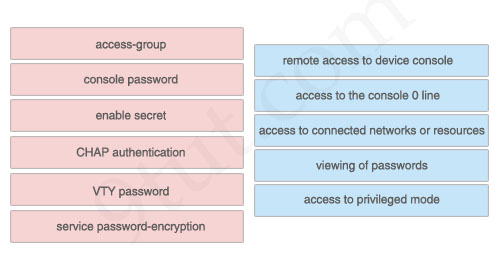
Answer:
1) VTY password: remote access to device console
2) console password: access to the console 0 line
3) access-group: access to connected networks or resources
4) service password-encryption: viewing of passwords
5) enable secret: access to privileged mode
The unselected left-box – CHAP – is used to verify the identity of the peer by means of a three-way handshake.
Question 14
Refer to the exhibit. PC-A is sending packets to the FTP server. Consider the packets as they leave RA interface Fa0/0 forwards RB. Drag the correct frame and packet address to their places in the table.
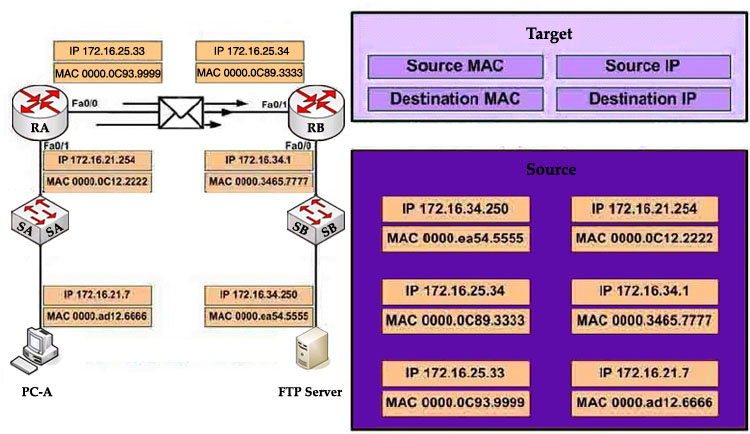
Answer:
Source MAC: 0000.0C93.9999
Destination MAC: 0000.0C89.3333
Source IP: 172.16.21.7
Destination IP: 172.16.34.250
Explanation
Remember these rules:
The IP addresses (of source and destination) of a packet never change during the transportation through the network. For example if PC-A wants to send a packet to PC-Z then the source and destination IP addresses of the packet will be the IP addresses of PC-A and PC-Z no matter how many devices they go through.
The MAC addresses, conversely, will change while passing the devices. The source MAC address is the address of the last sender and the destination MAC address is the address of the next device.
Question 15
As a network administrator, you are required to configure the network security policy. And the policy requires that only one host be permitted to attach dynamically to each switch interface. If that policy is violated, the interface should shut down. Which two commands must the network administrator configure on the 2950 Catalyst switch to meet this policy? Please choose appropriate commands and drag the items to the proper locations.
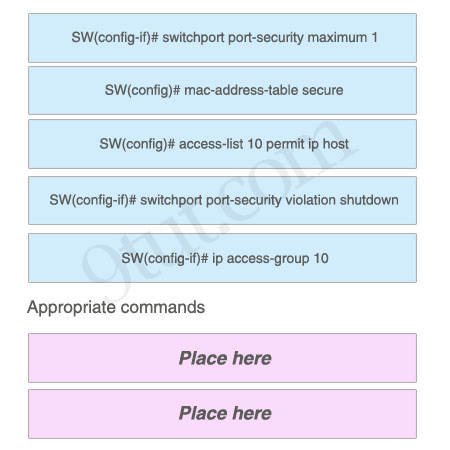 Answer:
Answer:
Appropriate commands:
SW(config-if)# switchport port-security maximum 1
SW(config-if)# switchport port-security violation shutdown
Question 16
The left describes boot sequence, while the right describes the orders. Drag the items on the left to the proper locations.
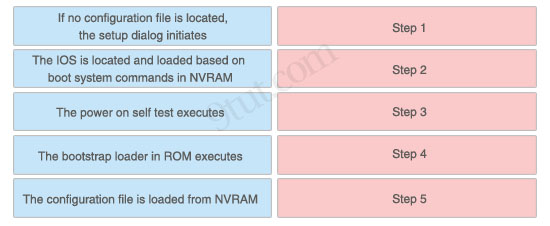
Answer:
1) Step 1: The power on self test executes.
2) Step 2: The bootstrap loader in ROM executes.
3) Step 3: The IOS is located and loaded based on boot system commands in NVRAM.
4) Step 4: The configuration file is loaded from NVRAM.
5) Step 5: If no configuration file is located, the setup dialog initiates.
Explanation
When a router boots up, it performs a series of steps, called the boot sequence, to test the hardware and load the necessary software. The boot sequence consists of the following steps:
1) Power on self test (POST): tests the hardware to verify that all components of the device are operational and present.
2) The bootstrap loader in ROM executes: The bootstrap loader is a program in ROM that is used to find where a valid Cisco IOS image is located.
3) If a valid Cisco IOS image is located, it is loaded.
4) IOS loads configuration file. Once the IOS image is loaded, it will search for a valid startup configuration in NVRAM.
5) If a valid startup configuration file cannot be found, the router will load the System Configuration Dialog (sometimes called setup mode). This mode allows you to perform the initial configuration of the router.
Question 17
Drag and Drop question. Drag the items to the proper locations.
Routing has been configured on the local router with these commands:
Local(config)# ip route 0.0.0.0 0.0.0.0 192.168.1.1
Local(config)# ip route 10.1.0.0 255.255.255.0 192.168.2.2
Local(config)# ip route 10.1.0.0 255.255.0.0 192.168.3.3
Drag each destination IP address on the top to its correct next hop address at the bottom.
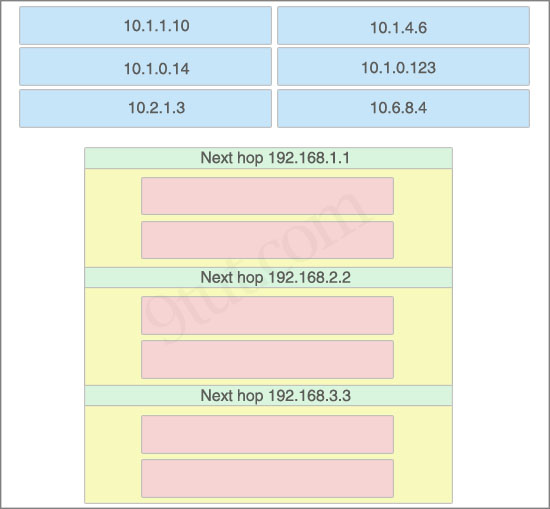 Answer:
Answer:
Next hop 192.168.1.1:
+ 10.2.1.3
+ 10.6.8.4
Next hop 192.168.2.2:
+ 10.1.0.14
+ 10.1.0.123
Next hop 192.168.3.3:
+ 10.1.1.10
+ 10.1.4.6
Explanation
If we have many entries matching for next hop ip address then the router will choose the one with most specific path to send the packet. This is called the “longest match” rule, the route with the most bits in the mask set to “1″ will be chosen to route packet.
For example, the destination IP address of 10.1.0.14 will match two “ip route” commands:
ip route 10.1.0.0 255.255.255.0 192.168.2.2
ip route 10.1.0.0 255.255.0.0 192.168.3.3
But the first command is more specific (10.1.0.0/24 is more specific than 10.1.0.0/16) so the packet will be routed to 192.168.2.2.
Note: The IP address 10.1.1.10 only matches the second command “ip route 10.1.0.0 255.255.0.0 192.168.3.3″. It does not match the command “ip route 10.1.0.0 255.255.255.0 192.168.2.2″ because the third octet is different (10.1.1.10 is different from 10.1.0.0/24).
Question 18
If a Cisco router has learned about network 10.1.1.0 from multiple sources, the router will select and install only one entry into the routing table. Indicate the order of preference that the router will use by dragging the routes on the left to the order of preference category on the right.
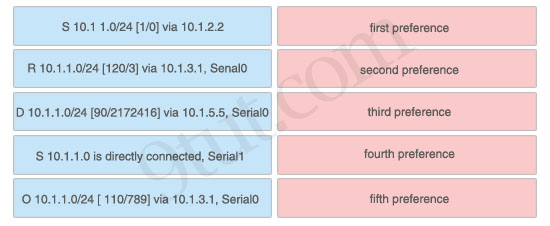 Answer:
Answer:
1) First preference: S 10.1.1.0 is directly connected, Serial1
2) Second preference: S 10.1 1.0/24 [1/0] via 10.1.2.2
3) Third preference: D 10.1.1.0/24 [90/2172416] via 10.1.5.5, Serial0
4) Fourth preference: O 10.1.1.0/24 [ 110/789] via 10.1.3.1, Serial0
5) Fifth preference: R 10.1.1.0/24 [120/3] via 10.1.3.1, Senal0
Explanation
Administrative distance is the first criterion that a router uses to determine which routing protocol to use if two protocols provide route information for the same destination. It is a measure of the trustworthiness of the source of the routing information. The smaller the administrative distance value, the more reliable the protocol.
In this question, notice that the destination of all routes is 10.1.1.0/24 so we need to use Administrative distance of each routing protocol to specify the priority of each route. Below lists the Administrative Distance default values of popular routing protocols:
+ Directly connected: 0
+ Static route: 1
+ EIGRP (symbolize by “D”): 90
+ OSPF (symbolize by “O”): 110
+ RIP (symbolize by “R”): 120
Question 19
Drag the function on the left to the matching security appliance or application on the right. (Not all functions are used)
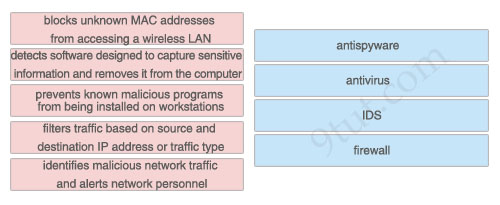 Answer:
Answer:
1) antispyware: detects software designed to capture sensitive information and removes it from the computer
2) antivirus: prevents known malicious programs from being installed on workstations
3) IDS: identifies malicious network traffic and alerts network personnel
4) firewall: filters traffic based on source and destination IP address or traffic type
Question 20
Drag the Frame Relay acronym on the left to match its definition on the right. (Not all acronyms are used)
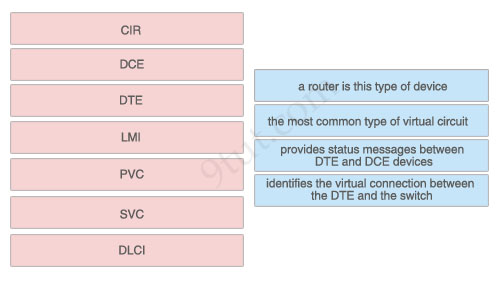
Answer:
1) a router is this type of device: DTE
2) the most common type of virtual circuit: PVC
3) provides status messages between DTE and DCE devices: LMI
4) identifies the virtual connection between the DTE and the switch: DLCI
Question 21
The left describes some types of connections while the right describes some types of cables. Drag the items on the left to the proper locations.
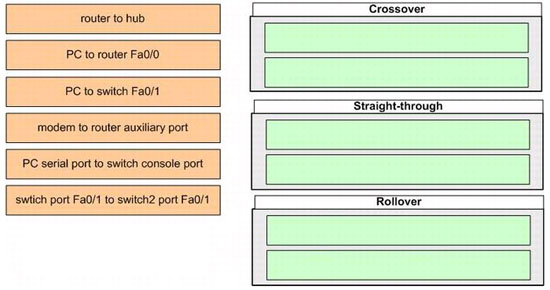 Answer:
Answer:
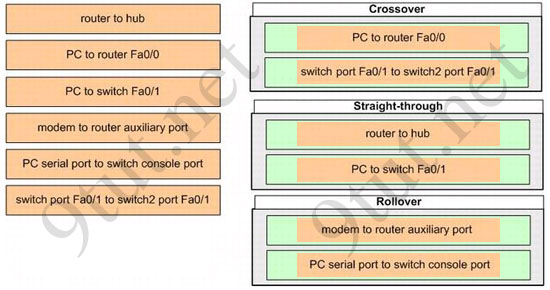
Explanation:
To specify when we use crossover cable or straight-through cable, we should remember:
Group 1: Router, Host(PC), Server
Group 2: Hub, Switch
One device in group 1 + One device in group 2: use straight-through cable
Two devices in the same group: use crossover cable
For example: we use straight-through cable to connect switch to router, switch to host, hub to host, hub to server… and we use crossover cable to connect switch to switch, switch to hub, router to router, host to host… ).
+ We can connect a modem to router auxiliary port using a rollover cable. Recall that the purpose of the router’s auxiliary port is for connecting to a modem and most Cisco routers have a second port on the back called the auxiliary port. We can use this port in case of a far-away router goes down, the administrator can have someone in the area go to the router, plug in a modem and access to the router remotely (if using the console port, we have to go to the site to work with that router).
+ We can connect a PC serial port to a switch/router console port through the RJ-45 to DB-9 or RJ-45 to DB-25 adapter (at the PC end), depending on the computer.
Question 22
The above provides some descriptions, while the below provides some routing protocols. Drag the above items to the proper locations.
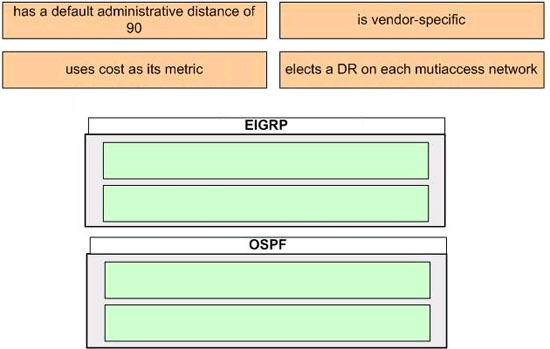 Answer:
Answer:
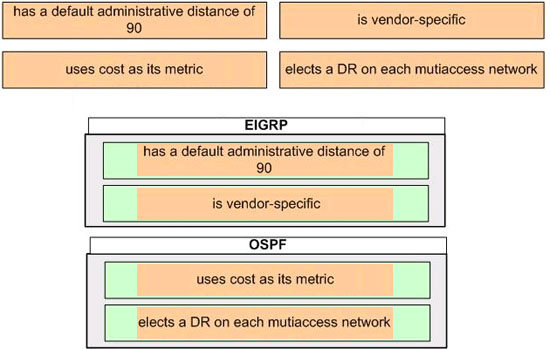
Explanation:
Enhanced Interior Gateway Routing Protocol (EIGRP) is a Cisco proprietary routing protocol, so it is vendor-specific. By default, EIGRP internal routes have an administrative distance value of 90.
OSPF uses cost as its metric. By default, the cost of an interface is calculated based on bandwidth with the formula cost= 10000 0000/bandwith (in bps). OSPF elects a DR on each broadcast and nonbroadcast multiaccess networks (like Ethernet and Frame Relay environments, respectively). It doesn’t elect a DR on point-to-point link (like a serial WAN).
Question 23
As a CCNA candidate, you are required to have a firm understanding of the OSI model. At which layers of the OSI model do Wide Area Networks operate in? Please drag the items to the proper locations.
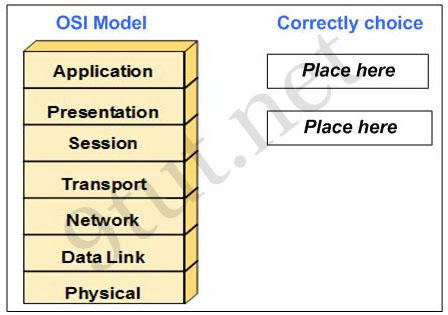
Answer:
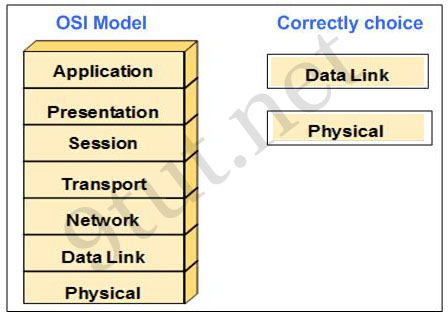
Explanation
WAN operates in the two lowest layers which are Data Link and Physical layers.
Question 1
Drag the Cisco default administrative distance to the appropriate routing protocol or route (Not all options are used)
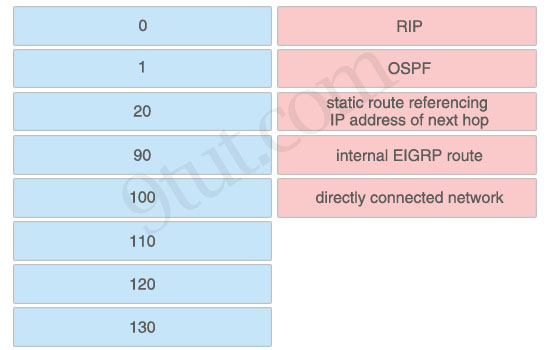 Answer:
Answer:
+ RIP: 120
+ OSPF: 110
+ static route referencing IP address of next hop: 1
+ internal EIGRP route: 90
+ directly connected network: 0
Question 24
Drag the term on the left to its definition on the right (not all options are used)
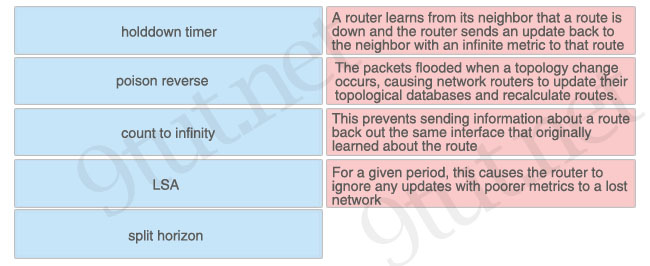 Answer:
Answer:
+ poison reverse: A router learns from its neighbor that a route is down and the router sends an update back to the neighbor with an infinite metric to that route
+ LSA: The packets flooded when a topology change occurs, causing network routers to update their topological databases and recalculate routes
+ split horizon: This prevents sending information about a routeback out the same interface that originally learned about the route
+ holddown timer: For a given period, this causes the router to ignore any updates with poorer metrics to a lost network
Question 25
Drag the description on the left to the correct router mode on the right
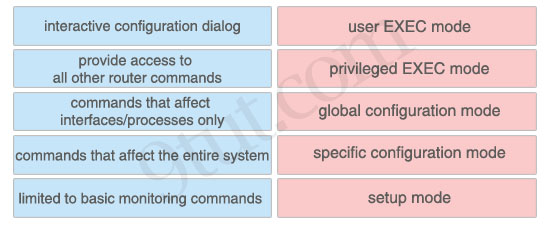
Answer:
+ user EXEC mode: limited to basic monitoring commands
+ privileged EXEC mode: provide access to all other router commands
+ global configuration mode: commands that affect the entire system
+ specific configuration mode: commands that affect interfaces/processes only
+ setup mode: interactive configuration dialog
Question 26
Drag each definition on the left to the matching term on the right
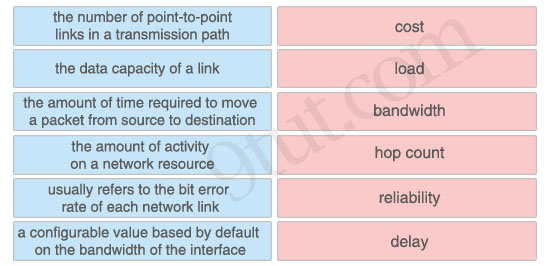
Answer:
+ cost: a configurable value based by default on the bandwidth of the interface
+ load: the amount of activity on a network resource
+ bandwidth: the data capacity of a link
+ hop count: the number of point-to-point links in a transmission path
+ reliability: usually refers to the bit error rate of each network link
+ delay: the amount of time required to move a packet from source to destination
Question 27
Refer to the exhibit. Complete the network diagram by dragging the correct device name or description to the correct location. Not all the names or descriptions will be used.
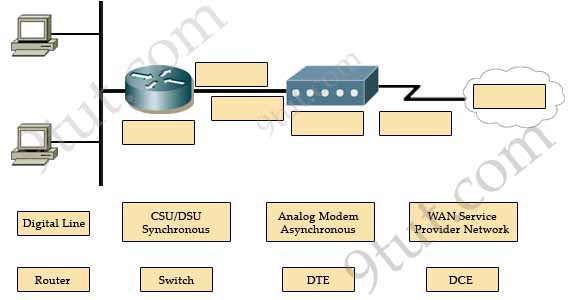
Answer:
From left to right:
Router, DTE, DCE, CSU/DSU Synchronous, Digital Line, WAN Service Provider Network.
Question 28
Drag each feature on the left to the appropriate routing protocol on the right.
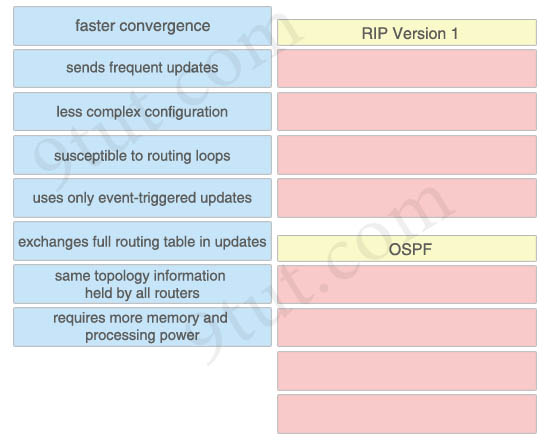
Answer:
RIP version 1
+ sends frequent updates
+ less complex configuration
+ susceptible to routing loops
+ exchanges full routing table in updates
OSPF:
+ faster convergence
+ uses only event-triggered updates
+ same topology information held by all routers
+ requires more memory and processing power
Question 29
Drag item on left to match item on right
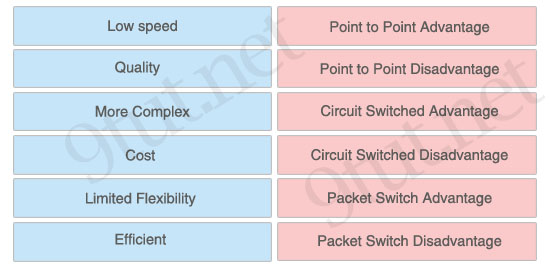
Answer:
+ Point to Point Advantage: Quality
+ Point to Point Disadvantage: Limited Flexibility
+ Circuit Switched Advantage: Cost
+ Circuit Switched Disadvantage: Low speed
+ Packet Switch Advantage: Efficient
+ Packet Switch Disadvantage: More Complex
Question 30
All hosts in the same subnet with 172.16.5.118/26 must be denied Telnet access to hosts outside the LAN (u need to just drag & drop) fill out the command. To complete the bracketed command, [access-list list-number deny tcp 172.16.5.address 0.0.0.mask any eq port], drag each appropriate option on the left to its proper placeholder on the right. (Not all options are used)
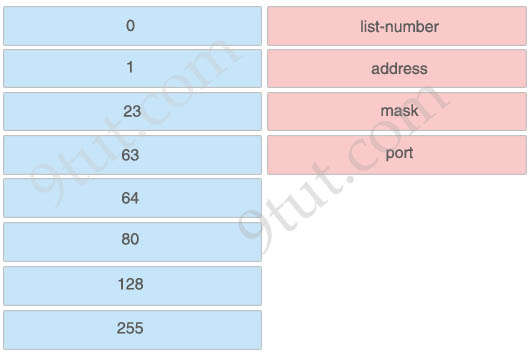
Answer:
+ list-number: 128
+ address: 64
+ mask: 63
+ port: 23
Explanation
In this case we want to filter port number so we have to use extended access-list so the list-number of our access-list must be from 100 to 199 -> We can choose 128. We need to find the range of the subnet 172.16.5.118/26:
Increment: 64 (/26 = 1111 1111. 1111 1111. 1111 11111. 1100 0000)
Network address: 172.16.5.64
The corresponding wildcard mask for /26 is 0.0.0.63 (because 63 = 0011 1111)
The port of Telnet access is 23 (and Telnet uses TCP). It is a well-known port that you must remember.
Therefore the full command to deny Telnet access to hosts outside the LAN 172.16.5.64 is:
access-list 128 deny tcp 172.16.5.64 0.0.0.63 any eq 23
A dental firm is redesigning the network that connects its three locations. The administrator gave the networking team 192.168.164.0 to use for addressing the entire netwok. After subnetting the address, the team is ready to assign the addresses. The administrator plans to configure ip subnet-zero and use RIP v2 as the routing protocol. As a member of the networking team, you must address the network and at the same time conserver unused addresses for future growth. With those goals in mind, drag the host addresses on the left to the correct router interface. Once of the routers is partially configured. Move your mouse over a router to view its configuration. Not all of the host addresses on the left are necessary.


In short, we should start calculating from the biggest network (with 16 hosts) to the smallest one using the formula 2n – 2 (n is the number of bits we need to borrow).Therefore:
16 hosts < 25 – 2 (we need to borrow 5 bits -> /27)
11 hosts < 24 – 2 (borrow 4 bits -> /28)
5 hosts < 23 – 2 (borrow 3 bits -> /29)
From the available ip addresses, we see that each of them has only one suitable solution (they are 192.168.164.149/27,192.168.164.166/28 and 192.168.164.178/29)
The smallest network is the Floss S0/0 which only requires 2 hosts = 22 – 2 (need to borrow 2 bits ->/30). There are 2 suitable answers: 192.168.164.189/30 and 192.168.164.188/30 but notice that 192.168.164.188/30 is the network address so we can not use it (because 188 = 4 * 47) -> we have to choose 192.168.164.189 as the correct solution.
In fact, it is not the formal way to solve a VLSM question so I recommend you to review your CCNA book if you haven’t grasped it well yet.
Question 2:
In order to complete a basic switch configuration, drag each switch IOS command on the left to its purpose on the right

Answer:
1) enable
2) configure terminal
3) hostname
4) Interface vlan 1
5) no shutdown
6) ip address
7) ip default-gateway
Question 3:
The Missouri branch office router is connected through its s0 interface to the Alabama Headquarters router s1 interface. The Alabama router has two LANs. Missouri users obtain Internet access through the Headquarters router. The network interfaces in the topology are addressed as follows: Missouri: e0 – 192.168.35.17/28; s0 – 192.168.35.33/28; Alabama: e0 – 192.168.35.49/28; e1 – 192.168.35.65/28; s1 – 192.168.35.34/28. The accounting server has the address of 192.168.35.66/28. Match the access list conditions on the left with the goals on the right. (Not all options on the left are used.)

1) deny ip 192.168.35.16 0.0.0.15 host 192.168.35.66
2) deny ip 192.168.35.55 0.0.0.0 host 192.168.35.66
3) permit ip 192.168.35.0 0.0.0.255 host 192.168.35.66
Explanation:
1) The wildcard mask of the command “deny ip 192.168.35.16 0.0.0.15 host 192.16.35.66″ is 0.0.0.15, which is equal to network mask of 255.255.255.240 = /28. So the access list will deny all traffic from network 192.168.35.16/28 from accessing host 192.16.35.66, which is the IP address of accounting server.
2) The command “deny ip 192.168.35.55 0.0.0.0 host 192.168.35.66″ will deny host 192.168.35.55, which is a user and belongs to interface e0 of Alabama router (192.168.35.49/28) from accessing accounting server.
3) Because there is an implicit “deny all” command at the end of each access list so the command “permit ip 192.168.35.0 0.0.0.255 host 192.168.35.66″ will only let network 192.168.35.0/24 access accounting server whilst prevent traffic from other networks.
Question 4:
A host with the address of 192.168.125.34/27 needs to be denied access to all hosts outside its own subnet. To accomplish this, complete the command in brackets, [access-list 100 deny protocol address mask any], by dragging the appropriate options on the left to their correct placeholders on the right.

Answer:
1) ip
2) 192.168.125.34
3) 0.0.0.0
Full command: access-list 100 deny ip 192.168.125.34 0.0.0.0
Question 5:
Drag and drop the network user application to the appropriate description of its primary use (not all options are used)

1) web browser
2) instant message
3) e-mail
4) database
5) collaboration
Question 6:
This topology contains 3 routers and 1 switch. Complete the topology.
| Drag the appropriate device icons to the labeled Device Drag the appropriate connections to the locations labeled Connections. Drag the appropriate IP addresses to the locations labeled IP address |
To remove a device or connection, drag it away from the topology.
Use information gathered from the Main router to complete the configuration of any additional routers. No passwords are required to access the Main router . The config terminal command has been disabled for the HQ router. The router does not require any configuration.
Configure each additional router with the following
| Configure the interfaces with the correct IP address and enable the interfaces. Set the password to allow console access to consolepw Set the password to allow telnet access to telnetpw Set the password to allow privilege mode access to privpw |
All devices have cable autosensing capabilities disabled.
All hosts are PC’s


The left describes OSI layers, while the right provides some terms. Drag the items on the right to the proper locations.

Network Layer:
1) IP addresses
2) packets
3) routing
Transport Layer:
1) windowing
2) UDP
3) segments
Question 8
The above describes some categories, while the below provides their corresponding router output lines. Drag the above items to the proper locations.

1) Port operational: Serial0/1 is up, line protocol is up
2) Layer 2 problem: Serial0/1 is up, line protocol is down
3) Layer 1 problem: Serial0/1 is down, line protocol is down
4) Port disabled: Serial0/1 is administrator down, line protocol is down
Explanation:
A simple way to find out which layer is having problem is to remember this rule: “the first statement is for Layer 1, the last statement is for Layer 2 and if Layer 1 is down then surely Layer 2 will be down too”, so you have to check Layer 1 before checking Layer 2. For example, from the output “Serial0/1 is up, line protocol is down” we know that it is a layer 2 problem because the first statement (Serial0/1 is up) is good while the last statement (line protocol is down) is bad. For the statement “Serial0/1 is down, line protocol is down”, both layers are down so the problem belongs to Layer 1.
There is only one special case with the statement “…. is administrator down, line protocol is down”. In this case, we know that the port is currently disabled and shut down by the administrators.
Question 9
A user is unable to connect to the Internet. Based on the layered approach to troubleshooting and beginning with the lowest layer. Follow the guide and drag the contents to relevant modules.

Answer:
1) Verify Ethernet cable connection: Step 1
2) Verify NIC operation: Step 2
3) Verify IP configuration: Step 3
4) Verify URL: Step 4
Explanation:
The question asks us to “begin with the lowest layer” so we have to begin with Layer 1: verify physical connection; in this case an Ethernet cable connection. For your information, “verify Ethernet cable connection” means that we check if the type of connection (crossover, straight-through, rollover…) is correct, the RJ45 headers are plugged in, the signal on the cable is acceptable…
Next we “verify NIC operation”. We do this by simply making a ping to the loopback interface 127.0.0.1. If it works then the NIC card (layer 1,2) and TCP/IP stack (layer 3) are working properly.
Verify IP configuration belongs to layer 3. For example, checking if the IP can be assignable for host, the PC’s IP is in the same network with the gateway…
Verifying the URL by typing in your browser some popular websites like google.com, microsoft.com to assure that the far end server is not down (it sometimes make we think we can’t access to the Internet). We are using a URL so this step belongs to layer 7 of the OSI model.
Question 10
The left describes the types of cables, while the right describes the purposes of the cables. Drag the items on the left to the proper locations. (Not all items can be used).

Answer:
1) straight-through: switch access port to router
2) crossover: switch to switch
3) rollover: PC COM port to switch
Explanation:
To remember which type of cable you should use, follow these tips:
- To connect two serial interfaces of 2 routers we use serial cable
– To specify when we use crossover cable or straight-through cable, we should remember:
Group 1: Router, Host, Server
Group 2: Hub, Switch
One device in group 1 + One device in group 2: use straight-through cable
Two devices in the same group: use crossover cable
For example: we use straight-through cable to connect switch to router, switch to host, hub to host, hub to server… and we use crossover cable to connect switch to switch, switch to hub, router to router, host to host… )
Question 11
The left describes the types of switch ports, while the right describes the features. Drag the options on the right to the proper locations.

Access Port:
- Carries traffic for a single VLAN
– Uses a straight-through cable to connect a device
– Connects an end-user workstation to a switch
Trunk Port:
- Carries traffic for a multiple VLAN
– Uses 802.1q to identify traffic from different VLANs
– Facilitates interVLAN communications when connected to a Layer 3 device
Question 12
The above describes the Spanning-Tree Protocol port states, while the below describes their functions. Drag the above items to the proper locations.

- Learning: populating the MAC address table but not forwarding data frames
– Forwarding: sending and receiving data frames
– Listening: preparing to forward data frames without populating the MAC address table
– Blocking: preventing the use of looped paths
Question 13
Drag the security features on the left to the specific security risks they help protect against on the right. (Not all options are used)

Answer:
1) VTY password: remote access to device console
2) console password: access to the console 0 line
3) access-group: access to connected networks or resources
4) service password-encryption: viewing of passwords
5) enable secret: access to privileged mode
The unselected left-box – CHAP – is used to verify the identity of the peer by means of a three-way handshake.
Question 14
Refer to the exhibit. PC-A is sending packets to the FTP server. Consider the packets as they leave RA interface Fa0/0 forwards RB. Drag the correct frame and packet address to their places in the table.

Answer:
Source MAC: 0000.0C93.9999
Destination MAC: 0000.0C89.3333
Source IP: 172.16.21.7
Destination IP: 172.16.34.250
Explanation
Remember these rules:
The IP addresses (of source and destination) of a packet never change during the transportation through the network. For example if PC-A wants to send a packet to PC-Z then the source and destination IP addresses of the packet will be the IP addresses of PC-A and PC-Z no matter how many devices they go through.
The MAC addresses, conversely, will change while passing the devices. The source MAC address is the address of the last sender and the destination MAC address is the address of the next device.
Question 15
As a network administrator, you are required to configure the network security policy. And the policy requires that only one host be permitted to attach dynamically to each switch interface. If that policy is violated, the interface should shut down. Which two commands must the network administrator configure on the 2950 Catalyst switch to meet this policy? Please choose appropriate commands and drag the items to the proper locations.

Appropriate commands:
SW(config-if)# switchport port-security maximum 1
SW(config-if)# switchport port-security violation shutdown
Question 16
The left describes boot sequence, while the right describes the orders. Drag the items on the left to the proper locations.

1) Step 1: The power on self test executes.
2) Step 2: The bootstrap loader in ROM executes.
3) Step 3: The IOS is located and loaded based on boot system commands in NVRAM.
4) Step 4: The configuration file is loaded from NVRAM.
5) Step 5: If no configuration file is located, the setup dialog initiates.
Explanation
When a router boots up, it performs a series of steps, called the boot sequence, to test the hardware and load the necessary software. The boot sequence consists of the following steps:
1) Power on self test (POST): tests the hardware to verify that all components of the device are operational and present.
2) The bootstrap loader in ROM executes: The bootstrap loader is a program in ROM that is used to find where a valid Cisco IOS image is located.
3) If a valid Cisco IOS image is located, it is loaded.
4) IOS loads configuration file. Once the IOS image is loaded, it will search for a valid startup configuration in NVRAM.
5) If a valid startup configuration file cannot be found, the router will load the System Configuration Dialog (sometimes called setup mode). This mode allows you to perform the initial configuration of the router.
Question 17
Drag and Drop question. Drag the items to the proper locations.
Routing has been configured on the local router with these commands:
Local(config)# ip route 0.0.0.0 0.0.0.0 192.168.1.1
Local(config)# ip route 10.1.0.0 255.255.255.0 192.168.2.2
Local(config)# ip route 10.1.0.0 255.255.0.0 192.168.3.3
Drag each destination IP address on the top to its correct next hop address at the bottom.

Next hop 192.168.1.1:
+ 10.2.1.3
+ 10.6.8.4
Next hop 192.168.2.2:
+ 10.1.0.14
+ 10.1.0.123
Next hop 192.168.3.3:
+ 10.1.1.10
+ 10.1.4.6
Explanation
If we have many entries matching for next hop ip address then the router will choose the one with most specific path to send the packet. This is called the “longest match” rule, the route with the most bits in the mask set to “1″ will be chosen to route packet.
For example, the destination IP address of 10.1.0.14 will match two “ip route” commands:
ip route 10.1.0.0 255.255.255.0 192.168.2.2
ip route 10.1.0.0 255.255.0.0 192.168.3.3
But the first command is more specific (10.1.0.0/24 is more specific than 10.1.0.0/16) so the packet will be routed to 192.168.2.2.
Note: The IP address 10.1.1.10 only matches the second command “ip route 10.1.0.0 255.255.0.0 192.168.3.3″. It does not match the command “ip route 10.1.0.0 255.255.255.0 192.168.2.2″ because the third octet is different (10.1.1.10 is different from 10.1.0.0/24).
Question 18
If a Cisco router has learned about network 10.1.1.0 from multiple sources, the router will select and install only one entry into the routing table. Indicate the order of preference that the router will use by dragging the routes on the left to the order of preference category on the right.

1) First preference: S 10.1.1.0 is directly connected, Serial1
2) Second preference: S 10.1 1.0/24 [1/0] via 10.1.2.2
3) Third preference: D 10.1.1.0/24 [90/2172416] via 10.1.5.5, Serial0
4) Fourth preference: O 10.1.1.0/24 [ 110/789] via 10.1.3.1, Serial0
5) Fifth preference: R 10.1.1.0/24 [120/3] via 10.1.3.1, Senal0
Explanation
Administrative distance is the first criterion that a router uses to determine which routing protocol to use if two protocols provide route information for the same destination. It is a measure of the trustworthiness of the source of the routing information. The smaller the administrative distance value, the more reliable the protocol.
In this question, notice that the destination of all routes is 10.1.1.0/24 so we need to use Administrative distance of each routing protocol to specify the priority of each route. Below lists the Administrative Distance default values of popular routing protocols:
+ Directly connected: 0
+ Static route: 1
+ EIGRP (symbolize by “D”): 90
+ OSPF (symbolize by “O”): 110
+ RIP (symbolize by “R”): 120
Question 19
Drag the function on the left to the matching security appliance or application on the right. (Not all functions are used)

1) antispyware: detects software designed to capture sensitive information and removes it from the computer
2) antivirus: prevents known malicious programs from being installed on workstations
3) IDS: identifies malicious network traffic and alerts network personnel
4) firewall: filters traffic based on source and destination IP address or traffic type
Question 20
Drag the Frame Relay acronym on the left to match its definition on the right. (Not all acronyms are used)

1) a router is this type of device: DTE
2) the most common type of virtual circuit: PVC
3) provides status messages between DTE and DCE devices: LMI
4) identifies the virtual connection between the DTE and the switch: DLCI
Question 21
The left describes some types of connections while the right describes some types of cables. Drag the items on the left to the proper locations.


To specify when we use crossover cable or straight-through cable, we should remember:
Group 1: Router, Host(PC), Server
Group 2: Hub, Switch
One device in group 1 + One device in group 2: use straight-through cable
Two devices in the same group: use crossover cable
For example: we use straight-through cable to connect switch to router, switch to host, hub to host, hub to server… and we use crossover cable to connect switch to switch, switch to hub, router to router, host to host… ).
+ We can connect a modem to router auxiliary port using a rollover cable. Recall that the purpose of the router’s auxiliary port is for connecting to a modem and most Cisco routers have a second port on the back called the auxiliary port. We can use this port in case of a far-away router goes down, the administrator can have someone in the area go to the router, plug in a modem and access to the router remotely (if using the console port, we have to go to the site to work with that router).
+ We can connect a PC serial port to a switch/router console port through the RJ-45 to DB-9 or RJ-45 to DB-25 adapter (at the PC end), depending on the computer.
Question 22
The above provides some descriptions, while the below provides some routing protocols. Drag the above items to the proper locations.


Enhanced Interior Gateway Routing Protocol (EIGRP) is a Cisco proprietary routing protocol, so it is vendor-specific. By default, EIGRP internal routes have an administrative distance value of 90.
OSPF uses cost as its metric. By default, the cost of an interface is calculated based on bandwidth with the formula cost= 10000 0000/bandwith (in bps). OSPF elects a DR on each broadcast and nonbroadcast multiaccess networks (like Ethernet and Frame Relay environments, respectively). It doesn’t elect a DR on point-to-point link (like a serial WAN).
Question 23
As a CCNA candidate, you are required to have a firm understanding of the OSI model. At which layers of the OSI model do Wide Area Networks operate in? Please drag the items to the proper locations.

Answer:

WAN operates in the two lowest layers which are Data Link and Physical layers.
Question 1
Drag the Cisco default administrative distance to the appropriate routing protocol or route (Not all options are used)

+ RIP: 120
+ OSPF: 110
+ static route referencing IP address of next hop: 1
+ internal EIGRP route: 90
+ directly connected network: 0
Question 24
Drag the term on the left to its definition on the right (not all options are used)

+ poison reverse: A router learns from its neighbor that a route is down and the router sends an update back to the neighbor with an infinite metric to that route
+ LSA: The packets flooded when a topology change occurs, causing network routers to update their topological databases and recalculate routes
+ split horizon: This prevents sending information about a routeback out the same interface that originally learned about the route
+ holddown timer: For a given period, this causes the router to ignore any updates with poorer metrics to a lost network
Question 25
Drag the description on the left to the correct router mode on the right

+ user EXEC mode: limited to basic monitoring commands
+ privileged EXEC mode: provide access to all other router commands
+ global configuration mode: commands that affect the entire system
+ specific configuration mode: commands that affect interfaces/processes only
+ setup mode: interactive configuration dialog
Question 26
Drag each definition on the left to the matching term on the right

+ cost: a configurable value based by default on the bandwidth of the interface
+ load: the amount of activity on a network resource
+ bandwidth: the data capacity of a link
+ hop count: the number of point-to-point links in a transmission path
+ reliability: usually refers to the bit error rate of each network link
+ delay: the amount of time required to move a packet from source to destination
Question 27
Refer to the exhibit. Complete the network diagram by dragging the correct device name or description to the correct location. Not all the names or descriptions will be used.

Answer:
From left to right:
Router, DTE, DCE, CSU/DSU Synchronous, Digital Line, WAN Service Provider Network.
Question 28
Drag each feature on the left to the appropriate routing protocol on the right.

Answer:
RIP version 1
+ sends frequent updates
+ less complex configuration
+ susceptible to routing loops
+ exchanges full routing table in updates
OSPF:
+ faster convergence
+ uses only event-triggered updates
+ same topology information held by all routers
+ requires more memory and processing power
Question 29
Drag item on left to match item on right

Answer:
+ Point to Point Advantage: Quality
+ Point to Point Disadvantage: Limited Flexibility
+ Circuit Switched Advantage: Cost
+ Circuit Switched Disadvantage: Low speed
+ Packet Switch Advantage: Efficient
+ Packet Switch Disadvantage: More Complex
Question 30
All hosts in the same subnet with 172.16.5.118/26 must be denied Telnet access to hosts outside the LAN (u need to just drag & drop) fill out the command. To complete the bracketed command, [access-list list-number deny tcp 172.16.5.address 0.0.0.mask any eq port], drag each appropriate option on the left to its proper placeholder on the right. (Not all options are used)

Answer:
+ list-number: 128
+ address: 64
+ mask: 63
+ port: 23
Explanation
In this case we want to filter port number so we have to use extended access-list so the list-number of our access-list must be from 100 to 199 -> We can choose 128. We need to find the range of the subnet 172.16.5.118/26:
Increment: 64 (/26 = 1111 1111. 1111 1111. 1111 11111. 1100 0000)
Network address: 172.16.5.64
The corresponding wildcard mask for /26 is 0.0.0.63 (because 63 = 0011 1111)
The port of Telnet access is 23 (and Telnet uses TCP). It is a well-known port that you must remember.
Therefore the full command to deny Telnet access to hosts outside the LAN 172.16.5.64 is:
access-list 128 deny tcp 172.16.5.64 0.0.0.63 any eq 23
Comment